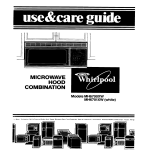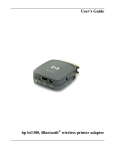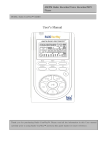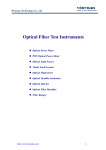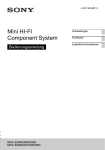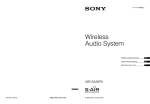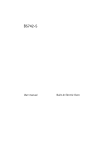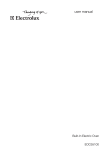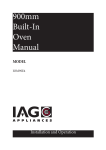Download USER MANUAL pH*K 2 1 - NWK
Transcript
¾¾¾¾¾¾¾¾¾¾¾¾¾¾¾¾¾¾¾¾¾¾¾¾¾¾¾¾¾¾¾¾¾¾¾¾¾¾¾¾ USER MANUAL pH*K 2 1 (Hand-probe for meat quality measurement) Version 5.nn alpha-numeric (Date of issue: 01.05.2011) NWK-Technology GmbH, Anton-Happach-Str. 13, 86932 Pürgen-Lengenfeld Tel: +49-8196/9311063, Fax: +49-8196/9311068 e-mail: [email protected], Internet: www.nwk-LL.de (C) Copyright by NWK-Technology GmbH ¾¾¾¾¾¾¾¾¾¾¾¾¾¾¾¾¾¾¾¾¾¾¾¾¾¾¾¾¾¾¾¾¾¾¾¾¾¾¾¾ Page 1 ¾¾¾¾¾¾¾¾¾¾¾¾¾¾¾¾¾¾¾¾¾¾¾¾¾¾¾¾¾¾¾¾¾¾¾¾¾¾¾¾ PREFACE Authors and developers of the pH*K21 Joachim Brammer Total conception, leadership development, programming of firmware Philipp Gianfrate Measuring technology Marianne Hofstetter Revised edition of the script © Copyright by NWK-Technology GmbH Anton-Happach-Str. 13 D-86932 Pürgen-Lengenfeld Germany Tel: +49-8196-93110-63 Fax: +49-8196-93110-68 FATTENTION! This user manual and the corresponding software are protected by copyright. It is strictly forbidden to copy, duplicate or sell this user manual and/or the software in any way without the permission of NWK-Technology GmbH. IBM, PC-DOS and SAA are registered trademarks of: International Business Machines Corp. MS-DOS, MS-Windows are registered trademarks of: Microsoft Corp. All additional programs and/or company names used in this user manual are also registered trademarks and must not be used for commercial purposes or in any other way. ¾¾¾¾¾¾¾¾¾¾¾¾¾¾¾¾¾¾¾¾¾¾¾¾¾¾¾¾¾¾¾¾¾¾¾¾¾¾¾¾ Page 2 ¾¾¾¾¾¾¾¾¾¾¾¾¾¾¾¾¾¾¾¾¾¾¾¾¾¾¾¾¾¾¾¾¾¾¾¾¾¾¾¾ LIST OF CONTENTS PREFACE ................................................................................................................................................................... 2 AUTHORS AND DEVELOPERS OF THE PH*K21 .................................................................................................................. 2 DIFFERENT PH-VALUES IN MEAT AND THEIR SIGNIFICANCE (SHORT VERSION) ............................... 6 PH-VALUE..................................................................................................................................................................... 6 PSE and DFD meat ................................................................................................................................................. 6 DFD-meat ............................................................................................................................................................... 7 GENERAL DESCRIPTION PH*K21 ....................................................................................................................... 8 Data transfer ......................................................................................................................................................... 10 BASIC TERMS PH*K21 ......................................................................................................................................... 11 ACTIVATING THE PH*K21 ................................................................................................................................. 12 ADJUSTMENT ACCORDING TO THE MEASUREMENTS REQUIRED ....................................................................................... 12 CONTROL FUNCTIONS........................................................................................................................................ 13 HOW TO CALL THE CONTROL FUNCTIONS ...................................................................................................................... 15 Display of the pH-value ......................................................................................................................................... 15 Display current number ......................................................................................................................................... 15 Display of the marking (tattooing) ......................................................................................................................... 15 Selecting the current measurement ........................................................................................................................ 16 Data output to printer or EDP ............................................................................................................................... 16 Selection of output data ......................................................................................................................................... 17 Deletion of data .................................................................................................................................................... 17 Adjustment of special functions ............................................................................................................................. 18 Selection of the output device/equipment ............................................................................................................... 19 Voltage display...................................................................................................................................................... 19 Display/Input date and time .................................................................................................................................. 20 Display load status pH*K21 .................................................................................................................................. 20 CHAPTER 1............................................................................................................................................................. 21 ADJUSTING A NUMBER WITH THE PH*K21 .................................................................................................................... 21 CHAPTER 2............................................................................................................................................................. 22 CHANGING THE CURRENT NUMBER (NO.)...................................................................................................................... 22 CHAPTER 3............................................................................................................................................................. 22 CHANGING OF THE MARKING (TATTOO NUMBER)........................................................................................................... 22 CHAPTER 4............................................................................................................................................................. 23 SELECTION OF THE DISPLAY MODE ............................................................................................................................... 23 CHAPTER 5............................................................................................................................................................. 24 DATA OUTPUT TO EDP/PC OR PRINTER. ....................................................................................................................... 24 CHAPTER 6............................................................................................................................................................. 25 OUTPUT RANGES (DATA SELECTION) ............................................................................................................................ 25 CHAPTER 7............................................................................................................................................................. 26 DELETION OF DATA ..................................................................................................................................................... 26 CHAPTER 8............................................................................................................................................................. 27 ADJUSTMENT OF SPECIAL FUNCTIONS ......................................................................................................... 27 MEANING OF THE SPECIAL FUNCTIONS .......................................................................................................................... 27 ¾¾¾¾¾¾¾¾¾¾¾¾¾¾¾¾¾¾¾¾¾¾¾¾¾¾¾¾¾¾¾¾¾¾¾¾¾¾¾¾ Page 3 ¾¾¾¾¾¾¾¾¾¾¾¾¾¾¾¾¾¾¾¾¾¾¾¾¾¾¾¾¾¾¾¾¾¾¾¾¾¾¾¾ special function 0 .................................................................................................................................................. 27 End of special functions and back to measuring mode. .......................................................................................... 27 special function 1 .................................................................................................................................................. 27 Test of the watchdog timer. .................................................................................................................................... 27 special function 2 .................................................................................................................................................. 27 Selection of the measuring precision (decimal point digits). .................................................................................. 27 special function 3 .................................................................................................................................................. 27 Adjustment of the temperature for the measuring medium. .................................................................................... 27 special function 4 .................................................................................................................................................. 29 Input marking mode. ............................................................................................................................................. 29 special function 5 .................................................................................................................................................. 29 Remote control mode ............................................................................................................................................. 29 special function 6 .................................................................................................................................................. 30 Input values first calibration solution .................................................................................................................... 30 special function 7 .................................................................................................................................................. 30 Input values second calibration solution................................................................................................................ 30 Special function 8.................................................................................................................................................. 31 Adjustment and output of firmware data ................................................................................................................ 31 Description of special function 8 subfunctions....................................................................................................... 32 Subfunction 0. No execution of special function .................................................................................................... 32 Subfunction 1. Printing of a pH*K21 status record................................................................................................ 32 Subfunction 2. Adjustment interface speed............................................................................................................. 32 Subfunction 50. Adjustment lifetime electrode ....................................................................................................... 32 Subfunction 65. Receiving addresses or customer data from the PC) ..................................................................... 32 Subfunction 68: Printout of addresses (customer data) .......................................................................................... 33 Subfunction 70: Printout of an error and calibration report .................................................................................. 34 Subfunction 76: Deletion of addresses (customer data).......................................................................................... 35 Subfunction 80: Adjustment of data transfer record for PC ................................................................................... 35 Subfunction 83: Change language of the pH*K21 ................................................................................................. 35 Subfunction 99: “View analog digit’s” .................................................................................................................. 36 Subfunction 102: “START LOAD 180”.................................................................................................................. 36 Subfunction 103: “START LOAD 0” ..................................................................................................................... 36 Subfunction 104: “RESTART AKKU” ................................................................................................................... 36 Subfunction 193: “SEND FIRMWARE DATA”...................................................................................................... 36 Subfunction 194: “RECEIVE FIRMWARE DATA”................................................................................................ 36 special function 9 .................................................................................................................................................. 37 Calibration of the pH*K21 .................................................................................................................................... 37 POSSIBLE ERRORS DURING CALIBRATION ...................................................................................................................... 39 CHANGING OF THE ELECTRODE .................................................................................................................... 40 ADJUSTMENT OF THE OUTPUT EQUIPMENT (PRINTER OR PC) .............................................................. 41 ADJUSTMENT OF DATE AND TIME .................................................................................................................. 42 ERROR TREATMENT IN THE PH*K21.............................................................................................................. 43 ERROR NUMBERS, CAUSES AND CLEARING .................................................................................................................... 43 ERROR: BLINKING DISPLAY.......................................................................................................................................... 46 The left side of the display is blinking.................................................................................................................... 46 The whole display is blinking................................................................................................................................. 46 ERRORS WHICH APPEAR IN PRACTICE ............................................................................................................................ 47 What happens if calibration is not possible?.......................................................................................................... 47 What happens if the current number isn’t counted upwards after each measurement? ........................................... 47 What happens if data transfer to printer or PC doesn’t function? .......................................................................... 47 What happens if the whole display is blinking? ...................................................................................................... 48 What happens if the display is inversed (light fonts on dark background)? ............................................................ 48 What happens if the display shows record used...................................................................................................... 48 What happens if the display shows full................................................................................................................... 48 ¾¾¾¾¾¾¾¾¾¾¾¾¾¾¾¾¾¾¾¾¾¾¾¾¾¾¾¾¾¾¾¾¾¾¾¾¾¾¾¾ Page 4 ¾¾¾¾¾¾¾¾¾¾¾¾¾¾¾¾¾¾¾¾¾¾¾¾¾¾¾¾¾¾¾¾¾¾¾¾¾¾¾¾ TECHNICAL DESCRIPTION OF DATA TRANSFER TO PC/EDP ................................................................... 49 DATA TRANSFER OF THE PH*K21 TO A PC .................................................................................................................... 49 Compilation data transmission record:.................................................................................................................. 49 Compilation data record: ...................................................................................................................................... 50 Data transfer ......................................................................................................................................................... 52 Set up of BCC (Block Control Check) .................................................................................................................... 52 Transmission of a record: ...................................................................................................................................... 53 Transmission of complete data to PC: ................................................................................................................... 53 TECHNICAL REQUIREMENTS: ........................................................................................................................................ 54 Pin configuration for the pH*K21: ........................................................................................................................ 54 REMOTE CONTROL OF THE PH*K21 .............................................................................................................. 55 TECHNICAL DESCRIPTION REMOTE CONTROL ................................................................................................................ 55 Remote control operation ...................................................................................................................................... 55 Commands in the remote control mode .................................................................................................................. 55 Transmission of a command to the pH*K21 ........................................................................................................... 56 RUNNING TIME OF THE ACCUMULATOR - CONTINUOUS OPERATION................................................. 57 WATCHDOGTIMER.............................................................................................................................................. 57 TECHNICAL DATA ............................................................................................................................................... 58 ¾¾¾¾¾¾¾¾¾¾¾¾¾¾¾¾¾¾¾¾¾¾¾¾¾¾¾¾¾¾¾¾¾¾¾¾¾¾¾¾ Page 5 ¾¾¾¾¾¾¾¾¾¾¾¾¾¾¾¾¾¾¾¾¾¾¾¾¾¾¾¾¾¾¾¾¾¾¾¾¾¾¾¾ Different pH-values in meat and their significance (short version) pH-value pH is a unit of measure which describes the degree of acidity or alkalinity of a solution. pH potentia Hydrogenii. strength of reaction of free hydrogen ion in one litre solution. The value is the negative logarithm of hydrogen ion concentration. acid range neutral alkaline range 0 to < 7 7 > 7 to 14 The pH-value of a living muscle is about 7.0. After slaughtering processes take place which cause a gradual reduction of the pH-value from initial values of 7 down to values between 5,3 and 6,5. This reduction is mainly caused by the production of lactic acid by glycolysis of the carbohydrate glycogen in the muscle; this production of lactic acid stops about 24 hours after slaughtering. The speed of the pH-value reduction and the level of the final pH-value (pH 24 h) are different depending on the animal and do considerably affect the quality of meat. PSE and DFD meat PSE-meat P S E Pale Soft Exudative = blaß = weich = wäßrig = wasserlässig 45 minutes after slaughtering the pH-value is already below 5,8. PSE-meat doesn’t appear evenly over the whole carcass but mostly (25 - 32 %) in cutlets and hams. Muscular rigidity takes place much quicker. Disadvantages of PSE-meat The loss of weight (due to hanging) is twice as high as in normal meat. Damp surface = strong germ increase. PSE-meat is not suitable for: · canned ham (high degree of jelly secretion) · smoked, rolled fillet of ham (considerable loss of weight, bad colour consistency) · raw sausage (bad consistency, wrinkles) · sausage to be heated in water ¾¾¾¾¾¾¾¾¾¾¾¾¾¾¾¾¾¾¾¾¾¾¾¾¾¾¾¾¾¾¾¾¾¾¾¾¾¾¾¾ Page 6 ¾¾¾¾¾¾¾¾¾¾¾¾¾¾¾¾¾¾¾¾¾¾¾¾¾¾¾¾¾¾¾¾¾¾¾¾¾¾¾¾ DFD-meat D F D Dark = dunkel Firm = fest Dry = trocken 45 minutes after slaughtering the pH-value is still above 6.3. The meat is of dry, dull, sticky or gluey consistency and dark-red colour. Disadvantages of DFD-meat The increase of undesired microorganism is supported by the high pH-value, i.e. the missing leavening. The meat is putrefying instead of ripening. The loss of weight (due to hanging) is higher than in normal meat. The perishability is reduced considerably. DFD-meat is not suitable for: · foil wrapping of whole pieces (putrefaction at +2°C within 7 days) · foil wrapping of portions (putrefaction at +2°C within 2 or 3 days) · foil wrapping sliced cold meat · raw sausage (partially suitable in case of high nitrate concentration) · salt meat ¾¾¾¾¾¾¾¾¾¾¾¾¾¾¾¾¾¾¾¾¾¾¾¾¾¾¾¾¾¾¾¾¾¾¾¾¾¾¾¾ Page 7 ¾¾¾¾¾¾¾¾¾¾¾¾¾¾¾¾¾¾¾¾¾¾¾¾¾¾¾¾¾¾¾¾¾¾¾¾¾¾¾¾ General description pH*K21 The pH*K21 is a hand-probe which is easy to use and absolutely suitable for slaughterhouses. The following characteristics do clearly point out the instrument’s usefulness. · Absolutely waterproof and fail-safe to breakage · Easy to handle, uncomplicated and free from interference · High measuring frequency with up to 600 measurements per hour · 5 languages directly selectable (German, English, French, Italian and Spanish) · Data transfer to computer and/or printer with serial interface RS-232 · User-specific evaluations are individually sortable and freely programmable · Accumulator operated (rechargeable) for approx. 10 hours of actual measuring time · 12 months guarantee on casing and functioning · Precise pH-determination of meat because of a second measurement, which means - measurement of pH 1 right after slaughtering 45 minutes pm - measurement of pH 2 after, for example, 24 hours · - measurement of pH 2 is automatically related to the current number of measurement pH 1 · Measuring range from 0°C to 80°C · Measuring range pH from 2 to 14 · Reproducible measured values · Measuring precision of +/- 0,03 pH · Integrated memory/storage for 4000 measurements consisting of: - 4000 pH 1, 4000 x date and time, 4000 pH 2, 4000 x date and time ¾¾¾¾¾¾¾¾¾¾¾¾¾¾¾¾¾¾¾¾¾¾¾¾¾¾¾¾¾¾¾¾¾¾¾¾¾¾¾¾ Page 8 ¾¾¾¾¾¾¾¾¾¾¾¾¾¾¾¾¾¾¾¾¾¾¾¾¾¾¾¾¾¾¾¾¾¾¾¾¾¾¾¾ · Data transfer to: - any IBM-compatible printer with serial interface - PC or Host-computer - electronic scale with operation from the pH*K21 (for example Bizerba MCIW) · Data transfer both simultaneous to measuring or after measuring to the required PC or printer · All data can be output sorted and selected · Automatic storage of the values measured · Output pH-value with one or two decimal points · Reaction times of approx. 2 seconds in operation · The glass electrode was developed especially for quality measurement in meat. The measuring probe made of "V2A high grade steel" with automatic protection of the electrode is covered by a protective steel case . A telescopic sleeve guarantees that the glass electrode will only leave the protective steel case for the measuring process. Unintentional damage to the electrode is therefore largely prevented by this protective measure (steel for use in the food environment 1.4301). ¾¾¾¾¾¾¾¾¾¾¾¾¾¾¾¾¾¾¾¾¾¾¾¾¾¾¾¾¾¾¾¾¾¾¾¾¾¾¾¾ Page 9 ¾¾¾¾¾¾¾¾¾¾¾¾¾¾¾¾¾¾¾¾¾¾¾¾¾¾¾¾¾¾¾¾¾¾¾¾¾¾¾¾ Data transfer The pH*K21 allows data transfer to any IBM-compatible printer with serial interface and/or to an EDP-equipment or host-computer, as well as to scales, both simultaneous to measuring and after measuring. The pH*K21 guarantees this thanks to its internal microcontroller. The pH*K21 can also be set to special remote control mode, which means that it can be used from EDP-equipment. Data can be selected or sorted as needed and can be output afterwards. A criterion can be individually specified. Data can be sorted according to: · · · · · current number, additional mark or sign, value pH 1, value pH 2 or time ¾¾¾¾¾¾¾¾¾¾¾¾¾¾¾¾¾¾¾¾¾¾¾¾¾¾¾¾¾¾¾¾¾¾¾¾¾¾¾¾ Page 10 ¾¾¾¾¾¾¾¾¾¾¾¾¾¾¾¾¾¾¾¾¾¾¾¾¾¾¾¾¾¾¾¾¾¾¾¾¾¾¾¾ Basic terms pH*K21 = RETURN: Confirmation / Enter = UP: Switching on the pH*K21 Display moves upwards/ next number next input point = DOWN: Start measurement Display moves downward/ previous number = CANCEL: CANCEL of input ¾¾¾¾¾¾¾¾¾¾¾¾¾¾¾¾¾¾¾¾¾¾¾¾¾¾¾¾¾¾¾¾¾¾¾¾¾¾¾¾ Page 11 ¾¾¾¾¾¾¾¾¾¾¾¾¾¾¾¾¾¾¾¾¾¾¾¾¾¾¾¾¾¾¾¾¾¾¾¾¾¾¾¾ Activating the pH*K21 To put the pH*K21 into operation, press this key for approximately 1 second (the pH*K21 turns off automatically one minute after the last operation). If the instrument is switched on, measurement is released and automatically stored with the key Before starting measuring, please observe the following points: · Is the measuring temperature adjusted correctly? · Is the instrument calibrated? · Is the output format adjusted correctly? · Is the right pH-value measured (pH1, pH2)? . Adjustment according to the measurements required There are the following possibilities to measure the pH-value: · · · · without connection to printer or PC -> with direct data transfer to PC -> with direct data transfer to scale -> with direct data transfer to printer -> adjust out. adjust out. adjust out. adjust out. device device device device none PC/EDP PC/EDP PRINTER After releasing a measurement, the pH*K21 automatically checks if the corresponding equipment is connected. If the connection to the output equipment is not confirmed within 20 seconds, an error message is given. During this stand-by period no further measurements can be carried out. To adjust the output equipment please see Adjustment of the output equipment (printer or PC), page 41. FATTENTION! In case of incorrect default settings or defective output equipment the pH*K21 displays an error message. You can then correct the default settings. FATTENTION! Please do observe the temperature of the measuring medium before starting measuring. To adjust the temperature see Adjustment of temperature for measuring and calibrating, page 27. ¾¾¾¾¾¾¾¾¾¾¾¾¾¾¾¾¾¾¾¾¾¾¾¾¾¾¾¾¾¾¾¾¾¾¾¾¾¾¾¾ Page 12 ¾¾¾¾¾¾¾¾¾¾¾¾¾¾¾¾¾¾¾¾¾¾¾¾¾¾¾¾¾¾¾¾¾¾¾¾¾¾¾¾ Control functions The pH*K21 gives you the following control functions. After switching on the instrument the current pH-value (P) is indicated. By pressing the key you can change the display. pH-value 1 14.64 = current pH-value (here 14.64) pH-value 2 14.64 = current pH-value right after measuring pH1 (measurement of pH2 is next) number 1 = Input/read in and display routine for current number To change the current number please see CHAPTER 2 , page 22. mark 1 = Input/read in and display routine to mark (identification/tattooing). To change the marking please see CHAPTER 3, page 22. meas. mode pH-1 = Input/read in routine for the display pH-1= measurement first pH-value (pH1) pH-2 = measurement second pH-value (pH2) pH-1,pH-2 = measurement of two pH-values in succession (pH1 then pH2) please see CHAPTER 4, page 23. , output data = Output of the data stored at the equipment selected under output data see CHAPTER 5, page 24 range = Input of output range (selections) (range = area). see CHAPTER 6, page 25 delete = Deletion of data (delete = deletion). data delete No. 5 = partial deletion (current number). data delete No. 7 = total deletion see CHAPTER 7, page 26 ¾¾¾¾¾¾¾¾¾¾¾¾¾¾¾¾¾¾¾¾¾¾¾¾¾¾¾¾¾¾¾¾¾¾¾¾¾¾¾¾ Page 13 ¾¾¾¾¾¾¾¾¾¾¾¾¾¾¾¾¾¾¾¾¾¾¾¾¾¾¾¾¾¾¾¾¾¾¾¾¾¾¾¾ special fun. = Input/read in routine for special functions see CHAPTER 8, page 27 out device = Adjustment of the output equipment none = no output PC/EDP = output to PC/EDP or scale PRINTER = output to printer see Adjustment of the output equipment (printer or PC), page 41. contrast = set contrast aCCU 7.83V = display current voltage of the accumulator (here 7.83 Volt) (by pressing the key in aCCU setting the instrument is switched off) POWERSUPPLY = supply voltage (here 12.0 Volt) 12.0V date 22.05.97 time 02:33.43 = Display of month, day and year (MM.DD.YY). Here March 12, 97 see Adjustment of date and time , page 40 = Display hours, minutes and second (HH.MM.SS). Here 233 43 sec. p.m. see Adjustment of date and time , page 40 load status = Loading condition of the pH*K21 no POWERSUP. = no power supply connected 1 minute test = short test accumulator (one minute unloading/discharging) discharge = unloading/discharging of the accumulator charge = loading/charging of the accumulator life charge ¾¾¾¾¾¾¾¾¾¾¾¾¾¾¾¾¾¾¾¾¾¾¾¾¾¾¾¾¾¾¾¾¾¾¾¾¾¾¾¾ Page 14 ¾¾¾¾¾¾¾¾¾¾¾¾¾¾¾¾¾¾¾¾¾¾¾¾¾¾¾¾¾¾¾¾¾¾¾¾¾¾¾¾ How to call the control functions Display of the pH-value When starting the pH*K21 the current measured pH-value is indicated. By pressing the key the measurement is released and stored. Display current number press 1 time The current number is shown for one second. press 1 time number indicates the input/read in routine for the current number. FATTENTION! If you want to change the current number please turn to CHAPTER 2 , page 22. If not press the following key. press 1 time return to measuring mode Display of the marking (tattooing) press 2 times mark indicates the input/read in routine for the marking FATTENTION! If you want to change the marking please refer to CHAPTER 3, page 22 . If not press the following key. press 1 time return to measuring mode ¾¾¾¾¾¾¾¾¾¾¾¾¾¾¾¾¾¾¾¾¾¾¾¾¾¾¾¾¾¾¾¾¾¾¾¾¾¾¾¾ Page 15 ¾¾¾¾¾¾¾¾¾¾¾¾¾¾¾¾¾¾¾¾¾¾¾¾¾¾¾¾¾¾¾¾¾¾¾¾¾¾¾¾ Selecting the current measurement press 3 times meas. mode is displayed. pH-1 = measurement of the first pH-value (for example pH45) pH-2 = measurement of the second pH-value (for example pH24) pH-1, pH-2 = first measurement of pH1 and then measurement of pH2 (for example first cutlet and then ham). FATTENTION! To change the measuring mode please refer to CHAPTER 4, page 23 . If not press the following key. press 1 time return to measuring mode Data output to printer or EDP press 4 times output data indicates the adjustment mode for data output. If the output equipment should be a printer, you will now be asked for the sorting. none = no sorting number = sorting according to the current number mark = sorting according to the marking pH-1 = sorting according to pH 1 pH-2 = sorting according to pH 2 time pH-1 = sorting according to time of pH 1 time pH-2 = sorting according to time of pH 2 Press the keys press 1 time and together to terminate the output return to measuring mode ¾¾¾¾¾¾¾¾¾¾¾¾¾¾¾¾¾¾¾¾¾¾¾¾¾¾¾¾¾¾¾¾¾¾¾¾¾¾¾¾ Page 16 ¾¾¾¾¾¾¾¾¾¾¾¾¾¾¾¾¾¾¾¾¾¾¾¾¾¾¾¾¾¾¾¾¾¾¾¾¾¾¾¾ Selection of output data press 5 times range: ready: number: mark: pH-value 1 : pH-value 2 : Here you can select the output data. Ready. Back to range Selection of the current number (0-9999) Selection of the marking (0-9999) Selection of the pH 1 (pH0.00 to pH99.99) Selection of the pH 2 (pH0.00 to pH99.99) FATTENTION! If you want to transfer specific data to the printer please refer to CHAPTER 6, page 25 . press 1 time return to measuring mode Deletion of data press 6 times Delete is the clearing/deleting function. FATTENTION! If you wish to delete data please refer to CHAPTER 7, page 26 . If not press the following key. press 1 time return to measuring mode ¾¾¾¾¾¾¾¾¾¾¾¾¾¾¾¾¾¾¾¾¾¾¾¾¾¾¾¾¾¾¾¾¾¾¾¾¾¾¾¾ Page 17 ¾¾¾¾¾¾¾¾¾¾¾¾¾¾¾¾¾¾¾¾¾¾¾¾¾¾¾¾¾¾¾¾¾¾¾¾¾¾¾¾ Adjustment of special functions press 7 times special fun. indicates the input routine for special functions (0 to 9) FATTENTION! If you want to change special functions please refer to CHAPTER 8, page 27 . If not press the following key. press 1 time return to measuring mode ¾¾¾¾¾¾¾¾¾¾¾¾¾¾¾¾¾¾¾¾¾¾¾¾¾¾¾¾¾¾¾¾¾¾¾¾¾¾¾¾ Page 18 ¾¾¾¾¾¾¾¾¾¾¾¾¾¾¾¾¾¾¾¾¾¾¾¾¾¾¾¾¾¾¾¾¾¾¾¾¾¾¾¾ Selection of the output device/equipment The selection of the output device is of great importance for data transfer. The system does offer you two possibilities for data transfer: to a printer or to a PC/scale. You have to select the device required here. press 8 times out device Here you have to select to which output device you want to transfer data. FATTENTION! If you want to change the adjustment for the output device please refer to Adjustment of the output equipment (printer or PC), page 41. If not press the following key. press 1 time return to measuring mode Voltage display Power supply of your hand-probe takes place by an accumulator. Therefore you have the possibility to ask for the residual voltage of the accumulator. This value always indicates the remaining voltage (real measuring time). press 9 times contrast shows you the brightness of the display press 10 times aCCU 7.93V Indicates the voltage of the accumulator (here 7.93 Volt). Press any key to continue. key - to switch off the instrument. press 1 time return to measuring mode press 11 times POWERSUPPLY 12,0V = Display voltage power supply (here 12.0 Volt) press 1 time return to measuring mode ¾¾¾¾¾¾¾¾¾¾¾¾¾¾¾¾¾¾¾¾¾¾¾¾¾¾¾¾¾¾¾¾¾¾¾¾¾¾¾¾ Page 19 ¾¾¾¾¾¾¾¾¾¾¾¾¾¾¾¾¾¾¾¾¾¾¾¾¾¾¾¾¾¾¾¾¾¾¾¾¾¾¾¾ Display/Input date and time press 12 time Display date DD.MM.JJ (day.month.year) key to adjust date and time press 1 time return to measuring mode press 13 times Display time HH:MM.SS (hours:minutes:second) key press 1 time to adjust date and time return to measuring mode FATTENTION! If you want to change the adjustment of date and time please refer to Adjustment of date and time , page 40 . If not press the following key. Display load status pH*K21 press 14 times load status NO POWERSUP 1 minute test DISCHARGE CHARGE life charge press 1time = Loading/charging conditions pH*K21. = No power supply connected. = Accumulator status determination. (One minute discharging. Short test accumu lator). = Complete discharging of the accumulator. = Recharging of the accumulator. = Loading/charging conservation of the accu mulator. return to measuring mode ¾¾¾¾¾¾¾¾¾¾¾¾¾¾¾¾¾¾¾¾¾¾¾¾¾¾¾¾¾¾¾¾¾¾¾¾¾¾¾¾ Page 20 ¾¾¾¾¾¾¾¾¾¾¾¾¾¾¾¾¾¾¾¾¾¾¾¾¾¾¾¾¾¾¾¾¾¾¾¾¾¾¾¾ CHAPTER 1 Adjusting a number with the pH*K21 To change a number in the pH*K21 please proceed as follows: Choose the number which has to be adjusted (for example current number, see CHAPTER 2 , page 22) press 1 time the number changes by 1 upwards By constant pressing the number keeps changing upwards up to max. 9999. By pressing this key (longer than 0.5 seconds) the numbers change by approx. 30 signs per second. With more than 100 changes (approx. 3.5 seconds) the number is changing in steps of 10. press 1 time the number changes by 1 downwards. By constant pressing the number keeps changing upwards. By pressing this key (longer than 0.5 seconds) the numbers change by approx. 30 signs per second. With more than 100 changes (approx. 3,5 seconds) the number is changing in steps of 10. press 1 time the number is selected and the display goes back to the current pH-value. together CANCEL: By pressing these two keys together input is terminated and the original value is not changed. In case you did select a point inadvertently this is very important. ¾¾¾¾¾¾¾¾¾¾¾¾¾¾¾¾¾¾¾¾¾¾¾¾¾¾¾¾¾¾¾¾¾¾¾¾¾¾¾¾ Page 21 ¾¾¾¾¾¾¾¾¾¾¾¾¾¾¾¾¾¾¾¾¾¾¾¾¾¾¾¾¾¾¾¾¾¾¾¾¾¾¾¾ CHAPTER 2 Changing the current number (No.) To perform the change mentioned above please follow the steps starting from the measuring mode. press as long as number appears. number indicates the input routine for the current number. press 1 time The cursor blinks under last number of the current number. To change the number please refer to CHAPTER 1, page 21. CHAPTER 3 Changing of the marking (tattoo number) To perform the change mentioned above please follow the steps starting from the measuring mode. press as long as mark appears. mark indicates the input routine for the marking. press 1 time The cursor blinks under the last number of the current marking. To change the marking please refer to CHAPTER 1, page 21. ¾¾¾¾¾¾¾¾¾¾¾¾¾¾¾¾¾¾¾¾¾¾¾¾¾¾¾¾¾¾¾¾¾¾¾¾¾¾¾¾ Page 22 ¾¾¾¾¾¾¾¾¾¾¾¾¾¾¾¾¾¾¾¾¾¾¾¾¾¾¾¾¾¾¾¾¾¾¾¾¾¾¾¾ CHAPTER 4 Selection of the display mode (Measurement of pH1, pH2 or first pH1 and then pH2) press as long as meas. mode appears. press 1 time Display blinks. meas. mode pH-1 = pH1-value is measured With the next measurement the pH1-value is measured and stored. If there has already been carried out a measurement with the current number, the display shows record used. The old measured value is overwritten. meas. mode pH-2 = pH2-value is measured With the next measurement the pH2-value is measured and stored. If there has already been carried out a measurement with the current number, the measurement is automatically related to this number. meas. mode pH-1, pH-2 = First pH1 is measured and right afterwards pH2. With the next measurement pH1 and then pH2 are measured. Only if both measurements were carried out, the data record is stored. If there is already a measurement with the current number, the display shows record used. The old measured value is overwritten. Please choose 1, 2 or 3. To change the number please refer to CHAPTER 1, page 21. ¾¾¾¾¾¾¾¾¾¾¾¾¾¾¾¾¾¾¾¾¾¾¾¾¾¾¾¾¾¾¾¾¾¾¾¾¾¾¾¾ Page 23 ¾¾¾¾¾¾¾¾¾¾¾¾¾¾¾¾¾¾¾¾¾¾¾¾¾¾¾¾¾¾¾¾¾¾¾¾¾¾¾¾ CHAPTER 5 Data output to EDP/PC or printer. press as long as output data appears. For this adjustment it is absolutely necessary to set the out.device mode. Please find detailed information at out. device mode (see Adjustment of the output equipment (printer or PC), page 41). press If you have entered a PC or an EDP in the out.device mode PC/ECP, data will be transferred directly now. If you have entered data output to PRINTER (printer output), you will now be asked for a sort specification. The following sorting options are possible: none = No sorting necessary. Data have already been sorted or the sequence is unimportant. number = Output sorted according to the current number mark = Output sorted according to the marking pH-value 1 = Output sorted according to pH 1 pH-value 2 = Output sorted according to pH 2 time pH-1 = Output sorted according to time of pH 1 time pH-2 = Output sorted according to time of pH 2 To change the number please refer to CHAPTER 1, page 21. If addresses are existing: If there are addresses stored in your pH*K21, you can here select the number of the address which should be output now. adress.no. none = No address adress.no. 1-999 = address number 0 to 999 To change the output key please refer to CHAPTER 1, page 21. press and together to end the output FATTENTION! If you haven’t connected an output device (printer, PC/EDP, scale) but selected an output range, please wait 20 seconds and the instrument will send the corresponding error message. After confirming the error message, the pH*K21 is again free for measurements. During a printing process you get the following display sending date please wait. After terminating this process the instrument automatically returns to the measuring mode. Sometimes it is necessary to enter a printout area before data output. Therefore please refer to CHAPTER 6, page 25 . ¾¾¾¾¾¾¾¾¾¾¾¾¾¾¾¾¾¾¾¾¾¾¾¾¾¾¾¾¾¾¾¾¾¾¾¾¾¾¾¾ Page 24 ¾¾¾¾¾¾¾¾¾¾¾¾¾¾¾¾¾¾¾¾¾¾¾¾¾¾¾¾¾¾¾¾¾¾¾¾¾¾¾¾ CHAPTER 6 Output ranges (data selection) press press press as long as range appears. range indicates the area. Here appears the range of the output area. The following selections are possible: ready = Ready. Back to output data. End of selection. pH-value 1 = Choose selection range for pH 1. pH-value 2 = Choose selection range for pH 2. mark = Choose selection range for marking. number = Choose selection range for current number. To change the number please refer to CHAPTER 1, page 21. Now you enter the “from” value. To change the number please refer to CHAPTER 1, page 21. Afterwards you enter the “to” value. To change the number please refer to CHAPTER 1, page 21. For the change the following areas are valid: number = 0 - 99.99 mark = 0 - 99.99 pH-value 1 = 0.00 - 99.99 pH-value 2 = 0.00 - 99.99 current number marking pH1 pH2 FATTENTION! All selection areas can be used in combination. If your pH*K21 does not output data, please check the adjustments mentioned above. After determining the output selection, the pH*K21 goes automatically back to the data output mode and you can enter the output address. ¾¾¾¾¾¾¾¾¾¾¾¾¾¾¾¾¾¾¾¾¾¾¾¾¾¾¾¾¾¾¾¾¾¾¾¾¾¾¾¾ Page 25 ¾¾¾¾¾¾¾¾¾¾¾¾¾¾¾¾¾¾¾¾¾¾¾¾¾¾¾¾¾¾¾¾¾¾¾¾¾¾¾¾ CHAPTER 7 Deletion of data press as long as Delete appears. This mode allows you to delete data. press 1 time The display shows the following: data delete No.: 0 Select data delete No.: 5 or data delete No.: 7. (To change the number please refer to CHAPTER 1, page 21). No.: 5 = Here all data in the area “FROM” current number to “TO” current number are deleted. To enter the selection please see CHAPTER 6, page 25. No.: 7 = Here all data stored in the pH*K21 are deleted. The remaining numbers do not have any significance. To change the number please see CHAPTER 1, page 21. press 1 time The selected function is confirmed and data are deleted. The system returns to measuring mode. FATTENTION! Attention when deleting data! Deleted data cannot be restored. ¾¾¾¾¾¾¾¾¾¾¾¾¾¾¾¾¾¾¾¾¾¾¾¾¾¾¾¾¾¾¾¾¾¾¾¾¾¾¾¾ Page 26 ¾¾¾¾¾¾¾¾¾¾¾¾¾¾¾¾¾¾¾¾¾¾¾¾¾¾¾¾¾¾¾¾¾¾¾¾¾¾¾¾ CHAPTER 8 Adjustment of special functions press until special fun. appears on the display. press Special function 1 is already given. Select the corresponding number with the key . FATTENTION! If you get stuck in your selection or do not know what you wanted to select please wait one minute without pressing any key and the pH*K21 is switched off automatically. By pressing the key you can start the input again. Meaning of the special functions special function 0 End of special functions and back to measuring mode. special function 1 Test of the watchdog timer. This is a test to check if the pH*K21 is still able to control itself. When selecting this function the pH*K21 has to act as if it has been newly-started. To confirm if this is the case, the display shows Special fun. WDT-Test. You have to confirm this by pressing the key . special function 2 Selection of the measuring precision (decimal point digits). Here you can determine if the pH-value is output with one or two digits after the decimal point. Measurement is always carried out with two digits after the decimal point. With adjustment at 1, the pH-value is rounded. special fun. decimals 1 = One digit after the decimal point. special fun. decimals 2 = Two digits after the decimal point. To change the number please see CHAPTER 1, page 21. special function 3 Adjustment of the temperature for the measuring medium. Here the temperature of the momentary measuring medium is adjusted. special fun. tmp. 20.°C = display of the momentary temperature. After pressing the key special fun. temperature 20.0°C appears and under the last digit the cursor blinks. ¾¾¾¾¾¾¾¾¾¾¾¾¾¾¾¾¾¾¾¾¾¾¾¾¾¾¾¾¾¾¾¾¾¾¾¾¾¾¾¾ Page 27 ¾¾¾¾¾¾¾¾¾¾¾¾¾¾¾¾¾¾¾¾¾¾¾¾¾¾¾¾¾¾¾¾¾¾¾¾¾¾¾¾ To change the number please refer to CHAPTER 1, page 21. ¾¾¾¾¾¾¾¾¾¾¾¾¾¾¾¾¾¾¾¾¾¾¾¾¾¾¾¾¾¾¾¾¾¾¾¾¾¾¾¾ Page 28 ¾¾¾¾¾¾¾¾¾¾¾¾¾¾¾¾¾¾¾¾¾¾¾¾¾¾¾¾¾¾¾¾¾¾¾¾¾¾¾¾ special function 4 Input marking mode. Here you can decide if the marking (tattoo number) is the same for every measurement or if it should be put to "zero (0)" after one measurement. Under usual working conditions this marking remains the same until the user changes it. special fun. mark mode leave = The marking remains. The value entered doesn’t change after one measurement. This is the normal mode and it can be used for tattoo number and so on. special fun. mark mode cleared = The marking is put to ZERO. The value entered returns to zero after one measurement. This is a special mode and it can be used for complaints and so on. To change the number please refer to CHAPTER 1, page 21. special function 5 Remote control mode To set the pH*K21 to remote control mode, please select special fun. remote ctrl. (no.5) . Please observe that this mode only works if the power supply is connected. The display shows remote ctrl. The instrument is now ready for remote control operation. If the instrument is not connected to a PC you can leave this mode by pressing the keys and together. To change the number please refer to CHAPTER 1, page 21. Otherwise you MUST enter 0 (zero) here. All other numbers can make the instrument carry out undesired functions. For technical description please refer to Remote control of the pH*K21, page 55 ¾¾¾¾¾¾¾¾¾¾¾¾¾¾¾¾¾¾¾¾¾¾¾¾¾¾¾¾¾¾¾¾¾¾¾¾¾¾¾¾ Page 29 ¾¾¾¾¾¾¾¾¾¾¾¾¾¾¾¾¾¾¾¾¾¾¾¾¾¾¾¾¾¾¾¾¾¾¾¾¾¾¾¾ special function 6 Input values first calibration solution Here you enter the pH value of the first calibration solution (neutral range, 6.88 or 7.0 or similar). This function is protected. For data input please proceed as follows: press The display shows the value of the momentarily entered calibration solution, solution 6.88. press The cursor blinks under the last number. Normally this value is 6.88. To change the number please refer to CHAPTER 1, page 21. Press keys and to return special function 7 Input values second calibration solution Here you enter the pH value of the second calibration solution (normally 4.00).This function is protected. For data input please proceed as follows: press The display shows the value of the momentarily entered calibration solution. press The cursor blinks under the last number. Normally this value is 4.00. To change the number please refer to CHAPTER 1, page 21. Press keys and to return FATTENTION! The two calibration solutions should cover the range in which measurements are taken. ¾¾¾¾¾¾¾¾¾¾¾¾¾¾¾¾¾¾¾¾¾¾¾¾¾¾¾¾¾¾¾¾¾¾¾¾¾¾¾¾ Page 30 ¾¾¾¾¾¾¾¾¾¾¾¾¾¾¾¾¾¾¾¾¾¾¾¾¾¾¾¾¾¾¾¾¾¾¾¾¾¾¾¾ Special function 8 Adjustment and output of firmware data Special function 8 is divided into several functions for adjusting the firmware (internal software of the pH*K21). You should not carry out any adjustments here without consulting your service. This function is protected. For data input please proceed as follows: press The display shows special 8. press special 8 and No.:0 appears. You can now select the function number. To change the number please refer to CHAPTER 1, page 21. ¾¾¾¾¾¾¾¾¾¾¾¾¾¾¾¾¾¾¾¾¾¾¾¾¾¾¾¾¾¾¾¾¾¾¾¾¾¾¾¾ Page 31 ¾¾¾¾¾¾¾¾¾¾¾¾¾¾¾¾¾¾¾¾¾¾¾¾¾¾¾¾¾¾¾¾¾¾¾¾¾¾¾¾ Description of special function 8 subfunctions Subfunction 0. No execution of special function This function returns to special fun. special 8 (see Adjustment and output of firmware data, page 31). Subfunction 1. Printing of a pH*K21 status record This function is only possible if a printer is connected. The adjustments of the pH*K21 are output. This output is needed for service. Subfunction 2. Adjustment interface speed Here you can change the interface speed (Baudrate) of your pH*K21. The following values are possible: Number 0 1 2 3 4 5 Baudrate 600 1200 2400 4800 9600 (Default!) 19200 Subfunction 50. Adjustment lifetime electrode With this function you fix the control data for the lifetime of an electrode. The first input is the number of insertions which can be carried out with the electrode. The number is input in "1000 insertions" which means that the input 5 is equal to 5000 insertions. The display shows 30 (here 30000 insertions). , for example 180 appears. After pressing the key This is the lifetime of the electrode in days. To change the number please refer to CHAPTER 1, page 21. Press and to return Subfunction 65. Receiving addresses or customer data from the PC) With this special function and a special software for PC customer-specific data can be transferred to the pH*K21. For data transfer: 1. Connect your PC to the pH*K21. 2. Start your PC software. 3. Select special function 8, subfunction 65. 4. The display shows adresses receive, start from the PC. Start data transfer at the PC. The pH*K21 is now waiting for data ¾¾¾¾¾¾¾¾¾¾¾¾¾¾¾¾¾¾¾¾¾¾¾¾¾¾¾¾¾¾¾¾¾¾¾¾¾¾¾¾ Page 32 ¾¾¾¾¾¾¾¾¾¾¾¾¾¾¾¾¾¾¾¾¾¾¾¾¾¾¾¾¾¾¾¾¾¾¾¾¾¾¾¾ Subfunction 68: Printout of addresses (customer data) This function is only possible if a printer is connected. Addresses which were transferred to the pH*K21 with special function 65 (please see Subfunction 65. Receiving addresses or customer data from the PC, page 32) can be printed out with this function. ¾¾¾¾¾¾¾¾¾¾¾¾¾¾¾¾¾¾¾¾¾¾¾¾¾¾¾¾¾¾¾¾¾¾¾¾¾¾¾¾ Page 33 ¾¾¾¾¾¾¾¾¾¾¾¾¾¾¾¾¾¾¾¾¾¾¾¾¾¾¾¾¾¾¾¾¾¾¾¾¾¾¾¾ Subfunction 70: Printout of an error and calibration report This function is only possible if a printer is connected. You can print out an error and calibration record as follows: Instrument data Number of instrument : Number of technician Number of customer Date of shipment Date of repair Change accumulator Change electrode Total measurements 2 : : : : : : : 3 1 22.02.94 15:00:00 (OK) 22.02.94 15:00:00 (OK) 22.02.94 15:00:00 (OK) 22.02.94 15:00:00 (OK) 64 Calibration record E1: ----E2: ----E3: ----E4: ----E5: ----RE: 22.02.94 16:51:30 (OK) Explanation Number of instrument: Number of technician: Number of customer: Date of shipment: Date of repair: Change of electrode: Total measurements: Serial number of the instrument Number of the responsible technician Number of the customer the instrument was shipped to Date and time of the first shipment of the instrument Date and time of the last repair Date and time of the last electrode change Number of measurements carried out with this electrode E1 - E5: RE: Date, time and status of the last calibrations Date, time and status of the last "firmware reset" ¾¾¾¾¾¾¾¾¾¾¾¾¾¾¾¾¾¾¾¾¾¾¾¾¾¾¾¾¾¾¾¾¾¾¾¾¾¾¾¾ Page 34 ¾¾¾¾¾¾¾¾¾¾¾¾¾¾¾¾¾¾¾¾¾¾¾¾¾¾¾¾¾¾¾¾¾¾¾¾¾¾¾¾ Subfunction 76: Deletion of addresses (customer data) Addresses which were transferred to the pH*K21 with special function 65 (see Subfunction 65. Receiving addresses or customer data from the PC, page 32) can be deleted completely. Subfunction 80: Adjustment of data transfer record for PC Here you can fix the data transfer record for the PC. 0 Normal data transfer record. (as described under Data transfer of the pH*K21 to a PC, page 49). This is the standard adjustment. 1 Customer-specific data format. Instead of the ACK/NAK confirmation the current number is used for "handshake". Subfunction 83: Change language of the pH*K21 With your pH*K21 you can choose among 5 languages. 0 German 1 English 2 French 3 Italian 4 Spanish 5 Polish ¾¾¾¾¾¾¾¾¾¾¾¾¾¾¾¾¾¾¾¾¾¾¾¾¾¾¾¾¾¾¾¾¾¾¾¾¾¾¾¾ Page 35 ¾¾¾¾¾¾¾¾¾¾¾¾¾¾¾¾¾¾¾¾¾¾¾¾¾¾¾¾¾¾¾¾¾¾¾¾¾¾¾¾ Subfunction 99: “View analog digits” This function is only for service purposes and must not be activated by the user. Subfunction 102: “START LOAD 180” This function is only for service purposes and must not be activated by the user. Subfunction 103: “START LOAD 0” This function is only for service purposes and must not be activated by the user. Subfunction 104: “RESTART AKKU” This function is only for service purposes and must not be activated by the user. Subfunction 193: “SEND FIRMWARE DATA” This function is only for service purposes and must not be activated by the user. Subfunction 194: “RECEIVE FIRMWARE DATA” This function is only for service purposes and must not be activated by the user. FA TTENTION! If you get stuck in your selection or if you don’t know what you want to select, please wait one minute without pressing any key and the pH*K21 automatically switches off. By pressing the key you can start the input again. FATTENTION! There are more special functions not described because of security reasons. They are only for service purposes and are of no significance for the user. Do not call any other subfunctions other than those described above! ¾¾¾¾¾¾¾¾¾¾¾¾¾¾¾¾¾¾¾¾¾¾¾¾¾¾¾¾¾¾¾¾¾¾¾¾¾¾¾¾ Page 36 ¾¾¾¾¾¾¾¾¾¾¾¾¾¾¾¾¾¾¾¾¾¾¾¾¾¾¾¾¾¾¾¾¾¾¾¾¾¾¾¾ special function 9 Calibration of the pH*K21 Before starting calibration the following conditions must be fulfilled: 1. Important note: To calibrate the pH*K21 it is necessary to use the protective case. During calibration the pHtip must be put in the calibration solution (standard buffer solution) together with the metallic casing of the glass electrode. 2. There must not be any deposition on the electrode. (if necessary the electrode must be cleaned). 3. The pH-values of the calibration solution must have been entered correctly. See special function 6, page 29 and special function 7, page 29. 4. The calibration solution must be filled in an appropriate receptacle. 5. The calibration solution should have room temperature (approx. 20°C - 25°C). press as long as special fun. appears on the display. press select press 8 times as long as calibrate appears. press 1 time select appears. ¾¾¾¾¾¾¾¾¾¾¾¾¾¾¾¾¾¾¾¾¾¾¾¾¾¾¾¾¾¾¾¾¾¾¾¾¾¾¾¾ Page 37 ¾¾¾¾¾¾¾¾¾¾¾¾¾¾¾¾¾¾¾¾¾¾¾¾¾¾¾¾¾¾¾¾¾¾¾¾¾¾¾¾ press 1 time electrode new? No. 0 appears. If you put in a new electrode and this is the first calibration you can communicate this to your pH*K21 by entering the number 523. The number of insertions and the date of the electrode change are also backspaced. For controlling electrodes, this number should only be entered when using an electrode for the first time. To change the number please see CHAPTER 1, page 21. press 1 time The calibration value set, normally solution 1 6.88 is displayed press 1 time A number is displayed at the bottom left. Now the probe has to be put into the first calibration solution. Please wait until the number stops changing. With pH 7.00 this value is theoretically 0. With pH 6.88 this value is theoretically 32. The value can differ by +/- 270. press 1 time and keep pressed until the display shows calibrate please wait. The first measuring point is now calibrated. Afterwards solution 2 appear with the value adjusted under special function 7. Normally 4.00 press 1 time A number is now displayed at the bottom left. Now the probe has to be put into the second calibration solution (normally 4.00). Please wait until the number stops changing. With pH 4.00 the value is theoretically 804. The value must not differ by more than +/- 160 plus calibration value 1. press 1 time and keep pressed until calibrate please wait is displayed. The second measuring point is now calibrated. ¾¾¾¾¾¾¾¾¾¾¾¾¾¾¾¾¾¾¾¾¾¾¾¾¾¾¾¾¾¾¾¾¾¾¾¾¾¾¾¾ Page 38 ¾¾¾¾¾¾¾¾¾¾¾¾¾¾¾¾¾¾¾¾¾¾¾¾¾¾¾¾¾¾¾¾¾¾¾¾¾¾¾¾ Possible errors during calibration 1. The pH-electrode was put out of the standard buffer solution during measuring. Repeat calibration according to the user manual. 2. The standard buffer solution is polluted and therefore not uniform. Renew calibration solution and calibrate again. 3. The pH-electrode is damaged because of - mechanical destruction - natural ageing Renew the pH-electrode. 4. The measuring electronic doesn’t work correctly. Please call your service and send the pH*K21 for inspection. FATTENTION! If you get stuck in your selection or if you don’t know what you want to select, please wait one minute without pressing any key and the pH*K21 automatically switches off. By pressing the key you can start the input again. To guarantee 100 per cent functionality of your instrument, the pH*K21 is calibrated before using. The calibration solutions should have room temperature (approx. 20°C - 25°C). ¾¾¾¾¾¾¾¾¾¾¾¾¾¾¾¾¾¾¾¾¾¾¾¾¾¾¾¾¾¾¾¾¾¾¾¾¾¾¾¾ Page 39 ¾¾¾¾¾¾¾¾¾¾¾¾¾¾¾¾¾¾¾¾¾¾¾¾¾¾¾¾¾¾¾¾¾¾¾¾¾¾¾¾ Changing of the electrode 1. Removing the electrode: · Please remove the protective cap at the top of the electrode · Please remove the protective case of the electrode (screwed). · Please remove the slit screws at the flange ring of the steel case (3 screws). · Now you can carefully remove the steel case from the electrode. · Attention! Do not tilt when removing the steel case, as the electrode can break. · Now the electrode can be removed from the screwing. · Now you should clean the surface of the flange ring from corrosion deposition. 2. Inserting the electrode: · First you have to screw the electrode into the thread. · Important! The electrode must not be screwed too tight, as the socket at the instrument can break. Furthermore there must not be any dirt between the electrode and the socket at the instrument. · Now the steel case can be put over the electrode. Attention! Do not tilt. · Please fasten the steel case with the slit screws at the flange ring. · The steel case can now be screwed. ¾¾¾¾¾¾¾¾¾¾¾¾¾¾¾¾¾¾¾¾¾¾¾¾¾¾¾¾¾¾¾¾¾¾¾¾¾¾¾¾ Page 40 ¾¾¾¾¾¾¾¾¾¾¾¾¾¾¾¾¾¾¾¾¾¾¾¾¾¾¾¾¾¾¾¾¾¾¾¾¾¾¾¾ Adjustment of the output equipment (printer or PC) press until out. device appears. You are now in the selection mode for special functions for the output. press 1 time Activate output adjustment. None = Measurement without output device PC/EDP = Measurement with PC/EDP PRINTER = Measurement with printer To change the number please refer to CHAPTER 1, page 21. ¾¾¾¾¾¾¾¾¾¾¾¾¾¾¾¾¾¾¾¾¾¾¾¾¾¾¾¾¾¾¾¾¾¾¾¾¾¾¾¾ Page 41 ¾¾¾¾¾¾¾¾¾¾¾¾¾¾¾¾¾¾¾¾¾¾¾¾¾¾¾¾¾¾¾¾¾¾¾¾¾¾¾¾ Adjustment of date and time press until DATE or TIME appears. press the display shows date input. You can now change the day. To change the number see CHAPTER 1, page 21. Press the key You can now change the calendar month. To change the number see CHAPTER 1, page 21. Press the key You can now change the calendar year. To change the number see CHAPTER 1, page 21. Press the key to display time. You can now change the hour to 24 hour format. To change the number see CHAPTER 1, page 21. Press the key You can now change the minutes. To change the numbers see CHAPTER 1, page 21. Press the key You can now change the seconds. To change the seconds see CHAPTER 1, page 21. Press to display start clock. start press to set the time adjusted. FATTENTION! You can stop adjusting date and time by pressing the keys together at any time. ¾¾¾¾¾¾¾¾¾¾¾¾¾¾¾¾¾¾¾¾¾¾¾¾¾¾¾¾¾¾¾¾¾¾¾¾¾¾¾¾ Page 42 ¾¾¾¾¾¾¾¾¾¾¾¾¾¾¾¾¾¾¾¾¾¾¾¾¾¾¾¾¾¾¾¾¾¾¾¾¾¾¾¾ Error treatment in the pH*K21 In the pH*K21 errors are described by the display Error which blinks followed by the error number (for example 20). Error numbers, causes and clearing The following error numbers are defined in the pH*K21: Error number 0 description no error 10 error data input. cause: Incorrect date. For example 02.30.1994. clearing: Enter a valid date. 20 printer inoperable. cause: Data output shows PRINTER and printout should be released. Printer is not connected. Printer is not switched on. Printer has no paper. The printer cable is defective. clearing: Clear the causes mentioned above. If the error message is still given, please call your service. 30 PC/EDP not connected. cause: Data output shows PC/EDP and data should be output. PC is not connected. PC is not switched on. PC-software didn’t start. PC-cable is defective. clearing: Clear the causes mentioned above. If the error message is still given, please call your service. 31 PC/EDP: no response or incorrect response. cause: Data output shows PC/EDP and data should be output. PC is not connected. PC is not switched on. PC-software didn’t start. Data transfer to PC is not adjusted correctly. PCcables defective. To adjust the data transfer rate please see Subfunction 2. Adjustment interface , page 32. clearing: Clear the causes mentioned above. If the error message is still given, please call your service. ¾¾¾¾¾¾¾¾¾¾¾¾¾¾¾¾¾¾¾¾¾¾¾¾¾¾¾¾¾¾¾¾¾¾¾¾¾¾¾¾ Page 43 ¾¾¾¾¾¾¾¾¾¾¾¾¾¾¾¾¾¾¾¾¾¾¾¾¾¾¾¾¾¾¾¾¾¾¾¾¾¾¾¾ Error number description 40 Marked as used, but not found. cause: Error in the pH*K21 memory. clearing: Delete all data stored in the pH*K21. see CHAPTER 7, page 26. 50 pH*K21 is full. cause: No more free memory capacity. clearing: Delete all data stored in the pH*K21. see CHAPTER 7, page 26. 60 Error during calibration of the first value. cause: During calibration the measured values fluctuate in nonpermissible tolerances. clearing: Clean the probe. If the error message is still given, please call your service. 61 Error during calibration of the second value. cause: During calibration the measured values fluctuate in nonpermissible tolerances. clearing: Clean the probe. If the error message is still given, please call your service. 70 Error during reading in of addresses. cause: Data transfer between PC and pH*K21 is disturbed, PC is not in transmit mode, the wrong programme has been started on the PC. clearing: Clear the causes mentioned above. If the error message is still given, please call your service. 71 Reading in of addresses. cause: Data transfer between PC and pH*K21 is disturbed, PC is not in transmit mode, the wrong programme has been started on the PC. clearing: Clear the causes mentioned above. If the error message is still given, please call your service. ¾¾¾¾¾¾¾¾¾¾¾¾¾¾¾¾¾¾¾¾¾¾¾¾¾¾¾¾¾¾¾¾¾¾¾¾¾¾¾¾ Page 44 ¾¾¾¾¾¾¾¾¾¾¾¾¾¾¾¾¾¾¾¾¾¾¾¾¾¾¾¾¾¾¾¾¾¾¾¾¾¾¾¾ Error number description 80 Error analogue module. cause: The measured value cannot be stored. clearing: Please call your service. 90 Remote control, no network. cause: You changed to remote control operation and didn’t connect the power supply. clearing: Connect the power supply. If the error message is still given, please call your service. 91 Remote control not initialised. cause: You changed to remote control operation and the probe is not calibrated, the firmware is not initialised. clearing: Calibrate the pH*K21. (see special function 9, page 37). If the error message is still given, please call your service. 100 Electrode: Lifetime passed. cause: The electrode in the instrument is older than the lifetime entered (please see subfunction 50. Adjustment lifetime of the electrode, page 31). clearing: Change the electrode. 101 Electrode: more than 75 % of the insertions have been carried out. cause: More than 75 % of the possible insertions have been carried out with the electrode in the instrument. This is only a warning. clearing: Please observe that you have a new electrode on stock. If so, please ignore this message. 102 Electrode: 100 % of the insertions. cause: There have been carried out more than the adjusted number of measurements. The electrode has to be changed. clearing: Change the electrode. 103 Electrode: error steepness. cause: You have a wrong calibration solution or the electrode or the measured value amplifier/repeater are defective. clearing: Control the calibration solutions. If the error message is still given, please change the electrode. If the error message still appears, please call your service. 104 Electrode: zero error. cause: You have a wrong calibration solution or the electrode or the measured value amplifier/repeater are defective. clearing: Control the calibration solutions. If the error message is still given, please change the electrode. If the error message still appears, please call your service. ¾¾¾¾¾¾¾¾¾¾¾¾¾¾¾¾¾¾¾¾¾¾¾¾¾¾¾¾¾¾¾¾¾¾¾¾¾¾¾¾ Page 45 ¾¾¾¾¾¾¾¾¾¾¾¾¾¾¾¾¾¾¾¾¾¾¾¾¾¾¾¾¾¾¾¾¾¾¾¾¾¾¾¾ Error: Blinking display The left side of the display is blinking cause 1: clearing: The pH*K21 is in remote control mode. This is not an error. It only indicates that the pH*K21 is in remote control mode. cause 2: clearing: Part of the firmware data is not initialised. Please call your service. The whole display is blinking No further measurements are possible. cause 1: clearing: Calibration got lost. Please carry out a new calibration according to the user manual. cause 2: clearing: The pH-electrode is damaged. a. because of mechanical destruction. b. because of natural ageing. Renew the pH-electrode. cause 3: clearing: The measuring electronic is not working correctly. Please call your service. ¾¾¾¾¾¾¾¾¾¾¾¾¾¾¾¾¾¾¾¾¾¾¾¾¾¾¾¾¾¾¾¾¾¾¾¾¾¾¾¾ Page 46 ¾¾¾¾¾¾¾¾¾¾¾¾¾¾¾¾¾¾¾¾¾¾¾¾¾¾¾¾¾¾¾¾¾¾¾¾¾¾¾¾ Errors which appear in practice What happens if calibration is not possible? Errors could be caused because of the following reasons: · incorrectly adjusted values special function 6 and/or 7. · polluted calibration solution. · defective tip/probe because of mechanical destruction. · polluted tip/probe. · measuring electronic doesn’t function correctly. What happens if the current number isn’t counted upwards after each measurement? Errors could be caused because of the following reasons: · the output device wasn’t adjusted correctly. · cable connection is defective. (To clear these errors please refer to CHAPTER 5, page 24) What happens if data transfer to printer or PC doesn’t function? Errors could be caused because of the following reasons: · the output device wasn’t adjusted correctly. · data transfer velocity wasn’t adjusted correctly. · cable connection is defective (or any other technical reasons which affect the instrument) and therefore printer or PC do not response. (To clear these errors please refer to CHAPTER 5, page 24 Subfunction 2. Adjustment interface , page 32) ¾¾¾¾¾¾¾¾¾¾¾¾¾¾¾¾¾¾¾¾¾¾¾¾¾¾¾¾¾¾¾¾¾¾¾¾¾¾¾¾ Page 47 ¾¾¾¾¾¾¾¾¾¾¾¾¾¾¾¾¾¾¾¾¾¾¾¾¾¾¾¾¾¾¾¾¾¾¾¾¾¾¾¾ What happens if the whole display is blinking? That means that no more measurements can be carried out. Errors could be caused because of the following reasons: · calibration data has been cleared. (Carry out a new calibration to eliminate this error) · measuring tip is defective because of mechanical destruction (Please contact your service) What happens if the display is inversed (light fonts on dark background)? · no firmware reset has been carried out. (Please contact your service) What happens if the display shows record used The display indicates that you have already carried out a measurement under this number. What happens if the display shows full The display indicates that you have already carried out the 4000 possible measurements. These measurements will be kept until storage. (To clear this error please refer to CHAPTER 7, page 26) ¾¾¾¾¾¾¾¾¾¾¾¾¾¾¾¾¾¾¾¾¾¾¾¾¾¾¾¾¾¾¾¾¾¾¾¾¾¾¾¾ Page 48 ¾¾¾¾¾¾¾¾¾¾¾¾¾¾¾¾¾¾¾¾¾¾¾¾¾¾¾¾¾¾¾¾¾¾¾¾¾¾¾¾ Technical description of data transfer to PC/EDP Data transfer of the pH*K21 to a PC Legend: sign SOH STX ETX EOT ENQ ACK BEL NAK ESC decimal 1 2 3 4 5 6 7 21 27 hexadecimal 01h 02h 03h 04h 05h 06h 07h 15h 1bh BCC Block Control Check Compilation data transmission record: STX Data ETX BCC Explanation Start sign STX Data End sign ETX Checksum BCC (Block Control Check) Number signs 1 Byte different (Variable data record length) 1 Byte 1 Byte ¾¾¾¾¾¾¾¾¾¾¾¾¾¾¾¾¾¾¾¾¾¾¾¾¾¾¾¾¾¾¾¾¾¾¾¾¾¾¾¾ Page 49 ¾¾¾¾¾¾¾¾¾¾¾¾¾¾¾¾¾¾¾¾¾¾¾¾¾¾¾¾¾¾¾¾¾¾¾¾¾¾¾¾ Compilation data record: All data record entries are separated by a comma. One data record consists of the following data items: A, K, F, LFNR, KENN, pH1, pH2, DATUM1, UHRZEIT1, DATUM2, UHRZEIT2 9, 2, 0, 123, 4321, 596, 571, 120394, 145520, 130394, 150020 (e.g.) Explanation of the data items: A Number of data items in this data record including this item. The data record is now limited to 9 data items. Because of expansion this number should be evaluated, as the number of data items can be increased without announcement. (This item can have 1 to 3 digits.) K Key for pH-data (1). For the LT*K21 the key is 2. (This item can have 1 to 3 digits.) (In the example: 1) F Error code probe. Here an error code can appear, so that the EDP can check if the pH*K21 is still OK (This item can have 1 to 4 digits.) (In the example: 0, no error) NUMBER Current number measurement. (This item can have 1 to 4 digits.) (In the example: 123) MARK Marking of measurement (tattoo/complaint). (This item can have 1 to 4 digits.) (In the example: 4321) ¾¾¾¾¾¾¾¾¾¾¾¾¾¾¾¾¾¾¾¾¾¾¾¾¾¾¾¾¾¾¾¾¾¾¾¾¾¾¾¾ Page 50 ¾¾¾¾¾¾¾¾¾¾¾¾¾¾¾¾¾¾¾¾¾¾¾¾¾¾¾¾¾¾¾¾¾¾¾¾¾¾¾¾ pH1 The value of measurement pH1 (hundredth pH without decimal point.) (this item can have 1 to 4 digits.) (in the example: 5,96) pH2 The value of measurement pH2 (hundredth pH without decimal point) (this item can have 1 to 4 digits.) (in the example: 5,71) DATE1 Date of measurement pH1 in the format MMDDJJ. TT = day, MM = month, JJ = year. (This item always has 6 digits) (In the example: 12 March 1994) TIME1 Date of measurement pH1 in the format HHMMSS. HH = hour, MM = minute, SS = second. (This item always has 6 digits) (In the example 14hour 55minutes and 20 seconds) DATE2 Date of measurement pH2 in the format MMDDJJ. TT = day, MM = month, JJ = year. (This item always has 6 digits) (In the example: 30.06.97) TIME2 Date of measurement pH2 in the format HHMMSS. HH = hour, MM = minute, SS = second. (This item always has 6 digits) (In the example 15hour 00minutes and 20 seconds) Please note: If a measured value (pH1 or pH2) cannot be found, the measured value, date and time have been set to 0. ¾¾¾¾¾¾¾¾¾¾¾¾¾¾¾¾¾¾¾¾¾¾¾¾¾¾¾¾¾¾¾¾¾¾¾¾¾¾¾¾ Page 51 ¾¾¾¾¾¾¾¾¾¾¾¾¾¾¾¾¾¾¾¾¾¾¾¾¾¾¾¾¾¾¾¾¾¾¾¾¾¾¾¾ Data transfer Example for a data record to be transmitted: ASCII: [STX] 11,1,0,123,4321,596,571,120394,145520,130394,150020[ETX][BCC] HEX: 02 31 31 30 31 34 35 35 31 31 31 31 03 31 2C 2C 32 33 39 37 32 34 33 35 3C 2C 33 32 36 31 30 35 30 30 2C 31 2C 2C 33 35 33 30 2C 39 32 39 32 34 2C 30 2C 34 2C 30 STX 11, 1, 0, 123, 4321, 596, 571, 120394, 145520, 130394, 150020 ETX,BCC Set up of BCC (Block Control Check) BCC is an "EXCLUSIV ODER" (XOR) connection of all byte of a data record. (STX and ETX, which stand for the beginning and the end of the text are not regarded). Example: Character BCC; BCC = 0 BCC = BCC XOR 31h(1) BCC = BCC XOR 31h(1) BCC = BCC XOR 2ch(,) BCC = BCC XOR 31h(1) . . BCC = BCC XOR 30h(0) ¾¾¾¾¾¾¾¾¾¾¾¾¾¾¾¾¾¾¾¾¾¾¾¾¾¾¾¾¾¾¾¾¾¾¾¾¾¾¾¾ Page 52 ¾¾¾¾¾¾¾¾¾¾¾¾¾¾¾¾¾¾¾¾¾¾¾¾¾¾¾¾¾¾¾¾¾¾¾¾¾¾¾¾ Transmission of a record: PC ACK NAK <-> <-<-<-<---> --> Probe STX Data ETX BCC (reception OK) (otherwise error) Explanation: The pH*K21 sends a complete data packet to the PC. The PC is decoding the data received according to the rules mentioned above and detects if they can be read as a message or as a complete data record. If this is the case, the computer sends an receipt confirmation to the pH*K21 and the next record can be sent. The positive response is an ACK, the negative one a NAK. If the pH*K21 doesn’t receive an ACK, but another sign, the record is sent again. If the pH*K21 doesn’t receive any response, the data record is sent again. The data record is sent up to a maximum of three times. If there doesn’t come any positive response from the PC by then, an error message is given. If the initial response was an ACK, the next measurement can be carried out. With out. device and the command PC data can be transmitted without interruption. Transmission of complete data to PC: The last data record consists of only one parameter. for example: [STX]1[ETX][BCC] For the PC this means the end of the data transmission. ¾¾¾¾¾¾¾¾¾¾¾¾¾¾¾¾¾¾¾¾¾¾¾¾¾¾¾¾¾¾¾¾¾¾¾¾¾¾¾¾ Page 53 ¾¾¾¾¾¾¾¾¾¾¾¾¾¾¾¾¾¾¾¾¾¾¾¾¾¾¾¾¾¾¾¾¾¾¾¾¾¾¾¾ Technical requirements: Baud rate: Parity: Data bits: Stop bits: Handshake: 9600 baud (or bit per second) none 8 1 no (or DTR/DSR) Apart from 9600 the following values can be chosen for baud rate: 600 1200 2400 4800 19200 The initial adjustment 9600. It should only be changed in an emergency, as all instruments known by us have no problem with this initial adjustment. If there are problems with peripheral devices, the reason is in most cases another one. (see Subfunction 2. Adjustment interface , page 32) Pin configuration for the pH*K21: Pin 1: Pin 2: Pin 3: Pin 4: Pin 5: Pin 6: Pin 7: RXD brown TXD grey +12 red GROUND yellow/green (GND) CTS pink GND blue RTS white ¾¾¾¾¾¾¾¾¾¾¾¾¾¾¾¾¾¾¾¾¾¾¾¾¾¾¾¾¾¾¾¾¾¾¾¾¾¾¾¾ Page 54 ¾¾¾¾¾¾¾¾¾¾¾¾¾¾¾¾¾¾¾¾¾¾¾¾¾¾¾¾¾¾¾¾¾¾¾¾¾¾¾¾ Remote control of the pH*K21 Technical description remote control Remote control operation Please put the pH*K21 in remote control operation, so that the display shows special fun. remote ctrl. (see Remote control mode, page 29). The PC should now start remote control operation by an [ESC L] command. Eventually a string can be displayed ([ESC A]). After sending the command the LCD display shows the normal measured value (pH-value) with the difference that the left digit position is blinking. Now the user or the PC can release measurements. They are stored by the pH*K21. The PC can call these measurements with [ESC S] if necessary (also more times). If the measurements of one “measuring group” are finished and transmitted, the PC should send an [ESC L] command. The measurements carried out until this time are marked as “sent” (pseudo deleted) and will not be transmitted with the next [ESC S] command. After terminating the remote control operation the PC should send an [ESC E] command to return to the normal measuring mode. If the remote control operation should need to be left without a PC, please press gether. and to- Commands in the remote control mode The remote control mode does offer the following commands: [ESC A] Display text string. The LCD display shows a character string which has to be confirmed with a key or the command [ESC X]. During the display of a string no measurements can be carried out. In case of other commands than [ESC A] or [ESC X] from the PC during display, the PC responses with EOT (command understood, but not carried out!). [ESC E] End of remote control operation. Herewith the remote control mode of the pH*K21 is left and the instrument returns to the normal measuring mode. [ESC L] Data marked as sent. All measurements starting from the last [ESC L] command are marked as sent and are not transmitted any more with the [ESC S] command. A new series of measurements can be started now. Data remain stored in the pH*K21 and can be transmitted afterwards at any time. [ESC M] Release measurement. With this command the PC can release a measurement. [ESC T] Measurement without storage and direct transfer of the data record. [ESC B] Measurement without storage and direct transfer of the pH-value only. [ESC S] Send data measured up to now. [ESC X] End of display. If an [ESC A] command was sent, the display of the character string can be stopped. ¾¾¾¾¾¾¾¾¾¾¾¾¾¾¾¾¾¾¾¾¾¾¾¾¾¾¾¾¾¾¾¾¾¾¾¾¾¾¾¾ Page 55 ¾¾¾¾¾¾¾¾¾¾¾¾¾¾¾¾¾¾¾¾¾¾¾¾¾¾¾¾¾¾¾¾¾¾¾¾¾¾¾¾ Transmission of a command to the pH*K21 The data record for a command transmission to the pH*K21 is structured as follows: [ESC] [command letter (E,L,M,S,X)] [BCC] or [ESC] [command letter (A)] [length of string] [string] [BCC] The BCC includes all characters of the data record (apart from the BCC itself). To calculate the BCC please see Set up of BCC (Block Control Check), page 50. PC <-> Command -> <<<- Probe ACK (Command understood and executed) or NAK (Command not understood) or EOT (Command understood but not executed) After the [ESC S] command the pH*K21 sends all data measured up to now. The format of data transferred is described under Data transfer of the pH*K21 to a PC, page 49. After the [ESC M] command the pH*K21 releases a measurement (without storing it) and sends the measured value (pH-1) to the PC. The format of data transferred is described under Data transfer of the pH*K21 to a PC, page 47. After the [ESC B] command the pH*K21 releases a measurement (without storing it) and sends only the measured value (with protocol) to the PC. The data record then is the following: STX Data ETX BCC. In this case the data record only consists of the pH-value measured right now * 100 (for example, `588´ for pH 5.88). ¾¾¾¾¾¾¾¾¾¾¾¾¾¾¾¾¾¾¾¾¾¾¾¾¾¾¾¾¾¾¾¾¾¾¾¾¾¾¾¾ Page 56 ¾¾¾¾¾¾¾¾¾¾¾¾¾¾¾¾¾¾¾¾¾¾¾¾¾¾¾¾¾¾¾¾¾¾¾¾¾¾¾¾ Running time of the accumulator - continuous operation The accumulator has a running time of approx. 8-10 hours without recharging. After that time it has to be recharged over the interface hub with the help of the power supply. This process takes about 12 hours; the accumulator can not be overloaded. If necessary, the pH*K21 can be permanently used with the power supply. Watchdog timer The pH*K21 does have a watchdog timer which checks the function of the instrument. If the instrument shouldn’t turn off at any time (no power supply connected) please put the plug of the power supply in the hub of the pH*K21 without putting the power supply in the socket of the network. The instrument does turn off now. F IMPORTANT NOTICE! The instrument should be cleaned after use. ¾¾¾¾¾¾¾¾¾¾¾¾¾¾¾¾¾¾¾¾¾¾¾¾¾¾¾¾¾¾¾¾¾¾¾¾¾¾¾¾ Page 57 ¾¾¾¾¾¾¾¾¾¾¾¾¾¾¾¾¾¾¾¾¾¾¾¾¾¾¾¾¾¾¾¾¾¾¾¾¾¾¾¾ Technical data measuring range pH: measuring precision: pH 2 to 14 +/- 0,03 pH temperature compensation: automatically serial interface: 600 - 19200 baud number of storable measurement: 4000 operation temperature range: storage temperature range: 0°C - 80°C -20°C - 80°C CPU: 16 Bit microcontroller ¾¾¾¾¾¾¾¾¾¾¾¾¾¾¾¾¾¾¾¾¾¾¾¾¾¾¾¾¾¾¾¾¾¾¾¾¾¾¾¾ Page 58 ¾¾¾¾¾¾¾¾¾¾¾¾¾¾¾¾¾¾¾¾¾¾¾¾¾¾¾¾¾¾¾¾¾¾¾¾¾¾¾¾ Index © © Copyright I 2 A Activating the pH*K21 Address number Adjusting a number Adjustment of data transfer record for PC Adjustment of the output equipment Authors and developers of the pH*K21 12 24 21 33 14 2 B Baudrate BCC (Block Control Check) 31 50, 54 C Calibration Calibration is not possible Calibration record Calibration solution Cancel Change of electrode Commands in the remote control mode Control functions Current number Current pH value Customer data from the PC 35 45 32 29 21 32 53 15 22 13 31 D Data output 24 Data selection 25 Data transfer 10, 12, 50 Data transfer to PC/EDP 47 Data transfer to printer or PC doesn’t function 45 Data transmission record 47 Date and time 40 Date of repair 32 Date of shipment 32 Day 14 Deletion of addresses 33 Deletion of data 13, 26 Display current voltage of the accumulator 14 E Error and calibration report Error numbers, causes and clearing Error treatment in the pH*K21 Errors which appear in practice 32 41 41 45 F Firmware Firmware reset 2 13 13 13 32 31 L Language Left side of the display is blinking LIST OF CONTENTS Loading condition 33 46 3 14 M Marking 22 Marking mode 28 Measurement of pH1, pH2 or first pH1 and then pH2 23 measurement of pH2 13 Measuring frequency 8 Measuring precision 56 Measuring range 56 measuring the pH-value 12 Minute 14 Month 14 N Number of customer 32 Number of technician 32 NWK-Binär Soft und Hardwareentwicklung GmbH 2 O Output equipment Output of the data stored Output ranges Output to PC/EDP or scale Output to printer 39 13 25 14 14 P Partial deletion pH*K21 Pin configuration PREFACE Printer or PC Printing Printout of addresses (customer data) Protocol 13 8, 11 52 2 39 24 31 31 R 30, 31 32 H Hour IBM Identification Input of output range Input/read in and display routine for marking Instrument data Interface speed 14 Remote control Remote control mode RETURN 53 28 11 S Selecting the current measurement 16 ¾¾¾¾¾¾¾¾¾¾¾¾¾¾¾¾¾¾¾¾¾¾¾¾¾¾¾¾¾¾¾¾¾¾¾¾¾¾¾¾ Page 59 ¾¾¾¾¾¾¾¾¾¾¾¾¾¾¾¾¾¾¾¾¾¾¾¾¾¾¾¾¾¾¾¾¾¾¾¾¾¾¾¾ Selection Selection range Selections Serial number Sorting Special functions Status Supply voltage Switch off 17, 25 25 13 32 16 27 31 14 14 T Tattoo Tattoo number 13 22 Technical data Technical description of data transfer to PC/EDP temperature for the measuring medium Total deletion Total measurements Transmission of complete data to PC Turn off 56 47 27 13 32 51 12 W Watchdog timer Watchdog timer ( WDT-Test) Whole display is blinking 55 27 46 ¾¾¾¾¾¾¾¾¾¾¾¾¾¾¾¾¾¾¾¾¾¾¾¾¾¾¾¾¾¾¾¾¾¾¾¾¾¾¾¾ Page 60




























































